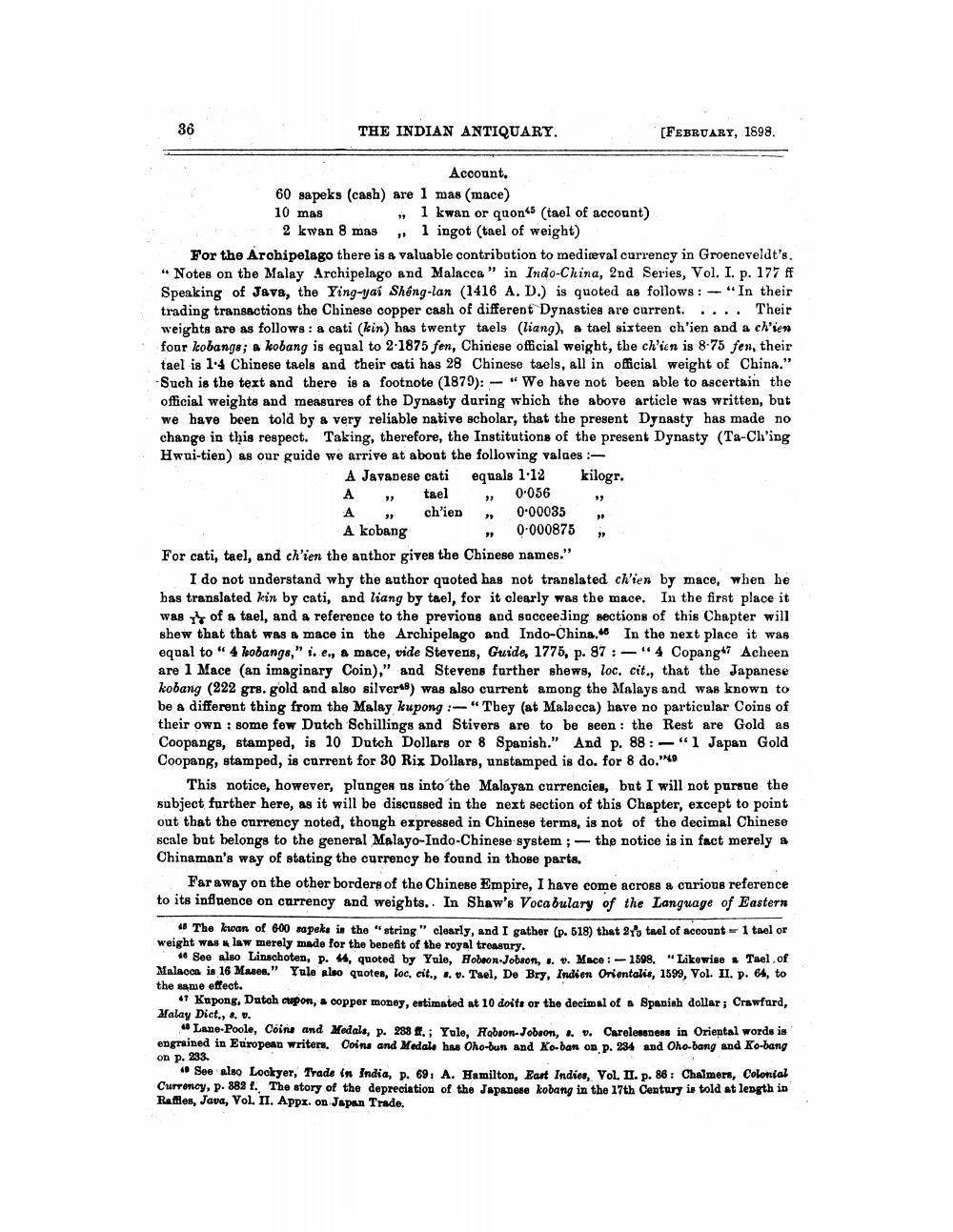________________
36
THE INDIAN ANTIQUARY.
[FEBRUARY, 1898.
Account. 60 sapeks (cash) are 1 mas (mace) 10 mas
1 kwan or quon"5 (tael of account) 2 kwan 8 mas 1 ingot (tael of weight) For the Archipelago there is a valuable contribution to medieval currency in Groeneveldt's. "Notes on the Malay Archipelago and Malacca" in Indo-China, 2nd Series, Vol. I. p. 177 ff Speaking of Java, the Ying-yai Sheng-lan (1416 A. D.) is quoted as follows: - "In their trading transactions the Chinese copper cash of different Dynasties are current.i... Their weights are as follows: a cati (kin) has twenty taels (liang), a tael sixteen ch'ien and a chien four lobangs; a kobang is equal to 2.1875 fen, Chinese official weight, the ch'ien is 8-75 fen, their tael is 1:4 Chinese taels and their cati has 28 Chinese taels, all in official weight of China." Such is the text and there is a footnote (1879): -“We have not been able to ascertain the official weights and measures of the Dynasty during which the above article was written, but we have been told by a very reliable native scholar, that the present Dynasty has made no change in this respect. Taking, therefore, the Institutions of the present Dynasty (Ta-Ch'ing Hwui-tien) as our guide we arrive at about the following valdes :
A Javanese cati equals 1.12 kilogr. A „ tael ► 0.056 A
ch'ien , 0.00035 , A kobang
0.0008757 For cati, tael, and ch'ien the author gives the Chinese names."
I do not understand why the author quoted has not translated chien by mace, when he bas translated kin by cati, and liang by tael, for it clearly was the mace. In the first place it was 4 of a tael, and a reference to the previous and succeeding sections of this Chapter will shew that that was a mace in the Archipelago and Indo-China. In the next place it was equal to "4 kobange," i. e., a mace, vide Stevens, Guide, 1775, p. 87 :- "4 Copang7 Acheen are 1 Mace (an imaginary Coin)," and Stevens further shews, loc. cit., that the Japanese kobang (222 grs. gold and also silver48) was also current among the Malays and was known to be a different thing from the Malay kupong :-"They (at Malacca) have no particular Coins of their own : some few Dutch Schillings and Stivers are to be seen: the Rest are Gold as Coopangs, stamped, is 10 Dutch Dollars or 8 Spanish." And p. 88:-"1 Japan Gold Coopang, stamped, is current for 30 Rix Dollars, unstamped is do. for 8 do."449
This notice, however, plunges us into the Malayan currencies, but I will not pursue the subject further here, as it will be discussed in the next section of this Chapter, except to point out that the currency noted, though expressed in Chinese terms, is not of the decimal Chinese scale but belongs to the general Malayo-Indo-Chinese system ; - the notice is in fact merely a Chinaman's way of stating the currency he found in those parts,
Far away on the other borders of the Chinese Empire, I have come across a curious reference to its influence on currency and weights. In Shaw's Vocabulary of the Language of Eastern
46 The kwan of 600 sapeks is the "string" clearly, and I gather (p. 518) that teel of account - 1 taol or weight was law merely made for the benefit of the royal treasury.
** See also Linschoten, p. 44, quoted by Yule, Hobeon-Jobson, ... Mace: -1598. "Likewise Tael.of Malacon in 16 Mases." Yule also quotes, loc. cit., s. v. Tael, De Bry, Indien Orientalis, 1599, Vol. II. P. 64, to the same effect.
41 Kupong, Datoh cepon, copper money, entimated at 10 doite or the decimal of a Spanish dollar, Crawford, Malay Dict., 8. u.
"Lane-Poole, Coins and Medals, p. 288 #.; Yule, Habaon-Jobson, .. 6. Carelessness in Orieptal words is engrained in European writers. Coins and Medale has Oho-bun and Ko-ban on p. 284 and Oho-bang and Ko-bang on p. 293.
• See also Lockyer, Trade in India, p. 69. A. Hamilton, East Indies, Vol. II. p. 86: Chalmers, Colonial Currency, p. 882 . The story of the depreciation of the Japanese kobang in the 17th Century is told at length in Raffles, Java, Vol. II. App. on Japan Trade.




